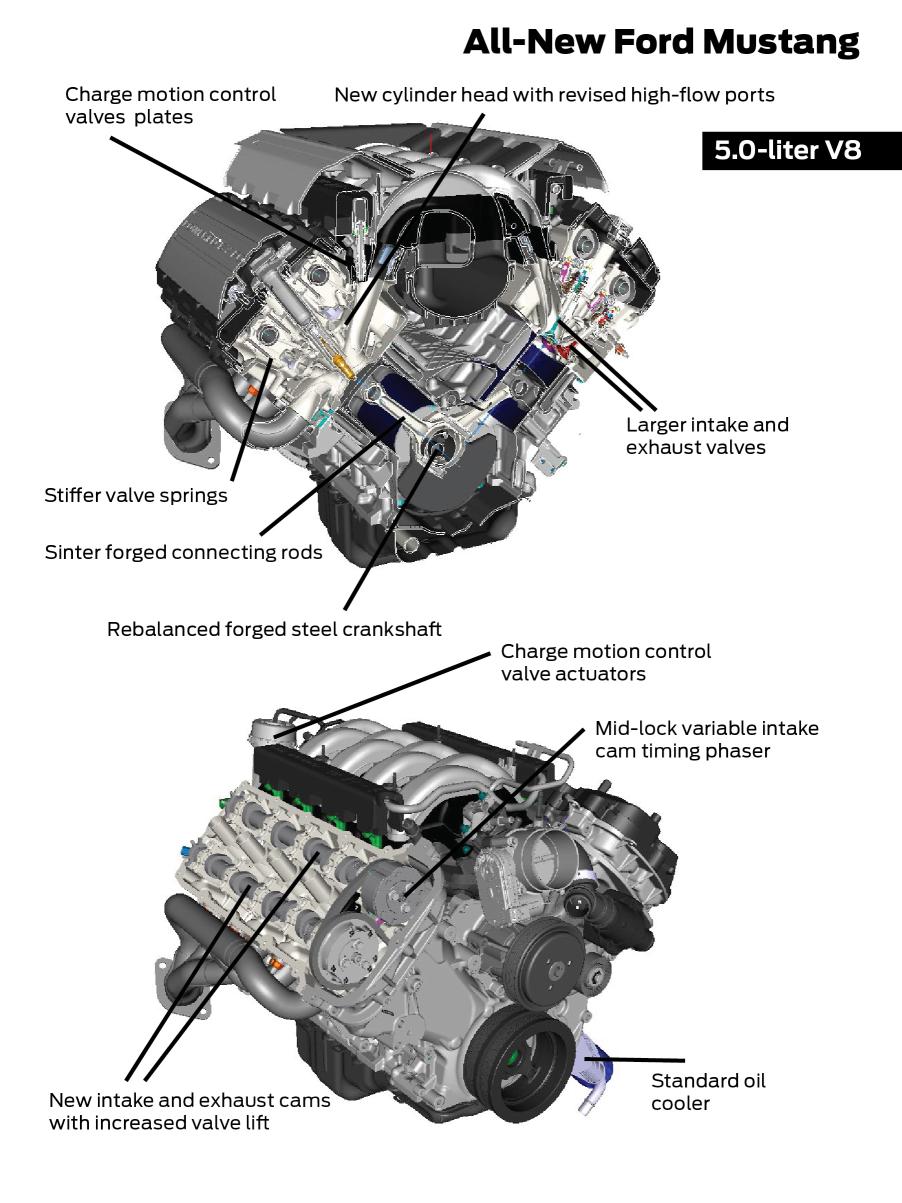- New 2.3-litre EcoBoost brings turbocharging to the new Mustang with exceptional power, torque and fuel efficiency
- 5.0-litre V8 engine delivers power and torque fans expect from the iconic brand
- Manual transmissions provide smooth shifting, automatic transmissions feature steering-wheel-mounted paddle shifters

BARCELONA, Spain, 5 December, 2013 – The all-new Ford Mustang offers a choice of advanced engines and manual or automatic transmissions, delivering power and performance worthy of the Mustang badge in any specification.
The all-new 2.3-litre EcoBoost engine brings turbocharging to the Mustang powertrain line-up. Designed to meet the needs of drivers looking for outstanding performance and fuel efficiency, this EcoBoost engine has been developed specifically for Mustang. The intake manifold and turbocharger housing are optimised to provide better breathing and higher output in Mustang.
With a projected output of more than 309 PS and 407 Nm of torque, this EcoBoost engine fits the bill for a true Mustang powerplant.
“This EcoBoost engine delivers the healthy output that Mustang drivers expect regardless of the speed with a broad, flat torque curve and great driveability under any conditions,” said Scott Makowksi, Ford EcoBoost powertrain engineering manager.
The newest member of Ford’s global family of EcoBoost engines, the 2.3-litre engine leverages state-of-the-art technologies including direct fuel injection, twin independent variable camshaft timing and turbocharging to produce big-engine power and torque with improved fuel efficiency.
This is the first Ford engine to utilise a low-inertia twin-scroll turbocharger that provides quicker boost response while enabling lower emissions and improved efficiency. The cylinder head features an integrated exhaust manifold that separates the inner and outer pairs of cylinders into each inlet passage to the turbo.
Keeping the exhaust pulses separated from the next cylinder in the firing order eliminates mixing losses and maximises pulse energy to the turbine wheel. The result is quicker torque delivery when the driver needs it for passing manoeuvres and similar performance to a twin-turbocharger configuration.
The separated exhaust ports also enable the exhaust valves to stay open longer for reduced pumping losses that improve specific fuel consumption by about 1 per cent.
With such high power output, ensuring durability was critical. Enhancements to the Mustang EcoBoost engine to withstand the stresses include:
- Forged-steel crankshaft
- Piston-cooling jets
- Steel piston ring carriers
- Premium bearing materials
- Upgraded valve seat materials
- Forged-steel connecting rods
- High-pressure die-cast aluminium cylinder block with ladder-frame bearing caps
- Deep-sump, die-cast aluminium oil pan
The beating heart of a Mustang
No Ford Mustang engine line-up would be complete without a great V8 engine at its core. The 5.0-litre V8 engine powers into a new generation with a host of upgrades that enable it to breathe better, especially at higher engine speeds.
Getting air into the cylinders and exhaust out is the key to generating more power and torque from any engine, and that has been the focus of development on the V8, which features:
- Larger intake valves
- Larger exhaust valves
- Revised intake camshafts
- Revised exhaust camshafts
- Stiffer valve springs – ensures that the valves close completely at high rpm
- New cylinder-head casting – revised ports that provide a straighter path to the valves for less-restrictive intake and exhaust flow; combustion chamber modifications accommodate larger valves
- Sinter forged connecting rods – lighter and more durable for high-rpm operation
- Redesigned piston tops – deeper cut-outs clear the new larger valves
- Rebalanced forged crankshaft – supports higher-rpm operation
These upgrades are projected to generate more than 426 PS and 529 Nm of torque.
A new intake manifold includes charge motion control valves to partially close off port flow at lower engine speeds. This increases the air charge tumble and swirl for improved air-fuel mixing. This results in better fuel economy, idle stability and lower emissions.
The variable camshaft timing on the intake side now has a greater range of adjustment available thanks to mid-lock phasers. This enables better optimised control of the valve timing over a broader range of engine speeds and loads for improved fuel economy and emissions.
Transmissions
Mustang blends outstanding all-around performance and everyday usability. Drivers who prefer to let the car handle the shifting during their daily work run, but still want to take control when the roads get twisty, will appreciate the new steering-wheel-mounted shift paddles with rev-matching downshifts that are now standard with the Select-Shift six-speed automatic transmission.
The automatic also features a redesigned case with cast-in ribs that help make it stiffer and reduce the weight. Internally clutches have been optimised and the operating temperature has been increased to reduce friction.
The new Mustang’s Getrag manual transmission has a shift linkage design for shorter throws and improved precision.
With a choice of powertrains to match driving styles and lifestyles, the new Mustang has contemporary technology under the hood to match its modern design and yet remain quintessentially Mustang.

